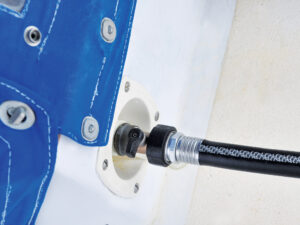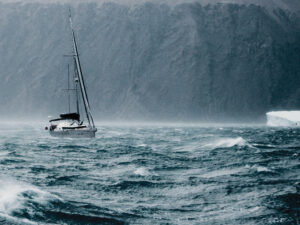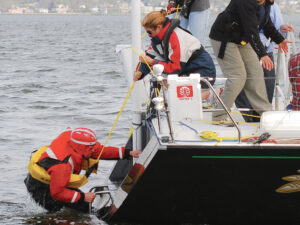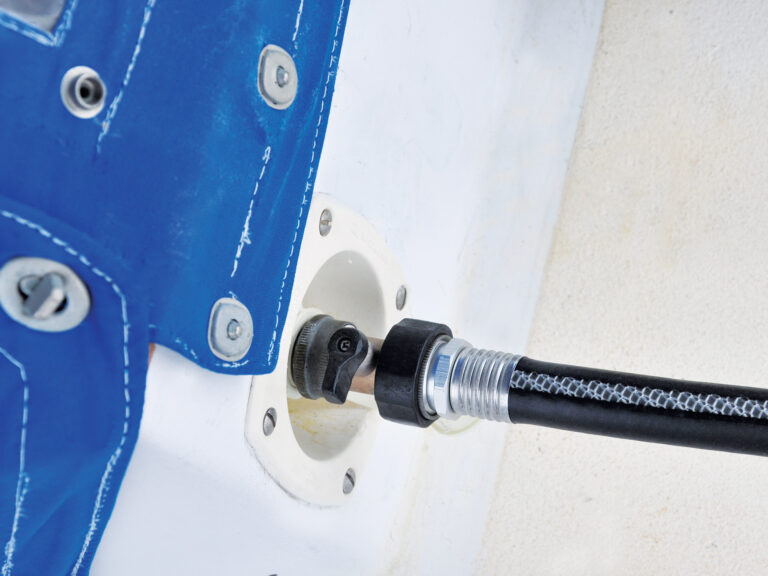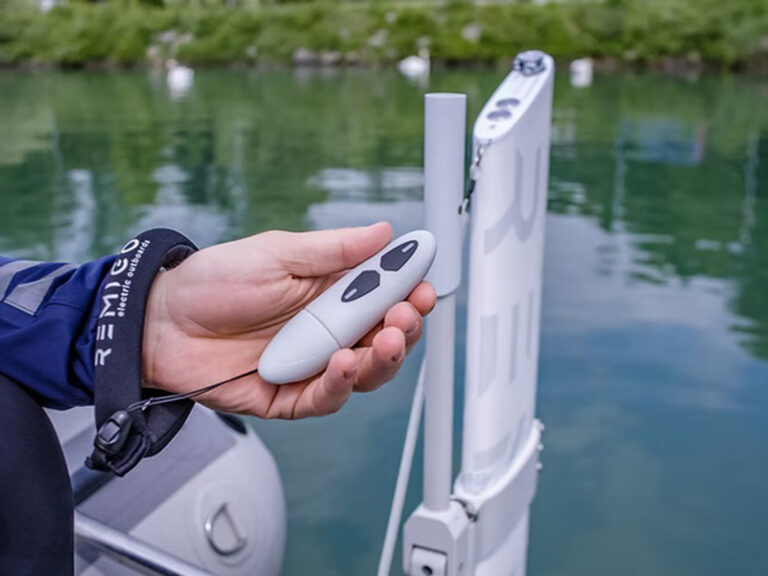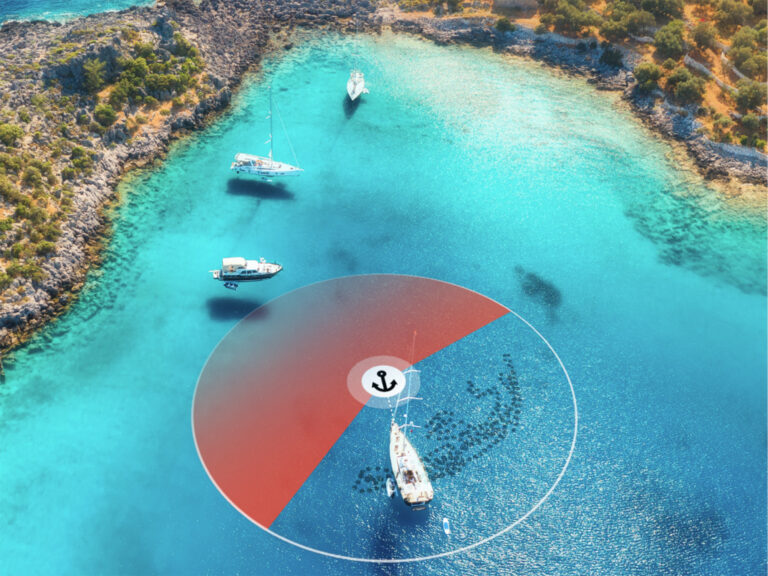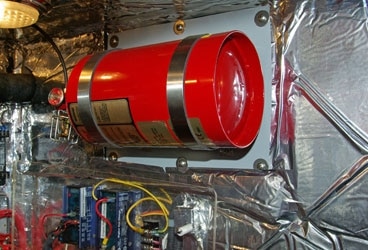
fight fire 368
The cry “Fire on board!” ranks right up there with “Crew overboard!” or “We’re sinking!” as among the worst things a cruising skipper can hear. Despite that, many cruising boats are ill prepared if a fire does strike. In fact, the vast majority of sailboats, unless they were built within the last several years, aren’t compliant with existing American Boat & Yacht Council or European Union standards that address fire suppression. If you own an older boat, you should take stock of the fire extinguishers and other fire-suppression equipment you have on board, then make the necessary upgrades so that if a blaze breaks out, you’re ready to fight it.
Onboard fires fall into two general categories: open fires, which may occur at a galley stove or in the main salon, and fires that start in closed spaces, such as your engine compartment. Both are dangerous, but fires that start in the engine space are more common, so preparing to face those will be the focus of this article.
Proper fire-suppression equipment comes in several tiers of sophistication, depending on a boat owner’s budget and desires. But in general, “clean agent” systems are recommended for most engine compartments. We’ll get to those in a minute, but first, it’s important to realize that in any firefighting situation, the last thing you want to do is add oxygen to the fire or risk having the extinguishing agent dissipate into an area other than where the fire is located. So, for example, if your boat doesn’t have a fixed-mounted system in its engine compartment and a fire breaks out, you definitely don’t want to open the compartment’s cover to see what’s going on. The best method for attacking such a fire is to inject the extinguishing agent into the space without opening any access panels.
Fire-Suppression Ports
For boats without a fixed-mounted fire-suppression system, and this includes many small to medium cruisers, the A.B.Y.C. adopted in 2000 what had been an International Standards Organization requirement in Europe for some time. Now A.B.Y.C. standard A-4 requires all engine compartments to have a fire-extinguisher port; typically, it’s located under a companionway step on the engine-box cover. In the event of a fire, you grab a nearby extinguisher, open the small port, insert the nozzle, and fire off the canister.
If you own an older boat, the addition of such a port is an easy Saturday-morning project that requires only a properly sized hole saw and the installation of a ready-made port. Ports are available from marine distributors and cost about $13.
Keep in mind that simply having the port isn’t enough. It’s not reasonable to assume that everyone on board will know what the function of this port is, especially in the panic that accompanies any onboard fire. Therefore, the A.B.Y.C. also requires the posting of a label that provides the requisite instructions on how to use the port and an extinguisher in the event of a fire. A prudent skipper reviews these instructions with crewmembers as part of any safety briefing.
Note that boatbuilders outside of the United States often favor a simple graphic to indicate, say, the function of a port or to warn of moving machinery inside a compartment rather than providing a label describing in words what to do in the event of a fire.
Once you’ve installed a port, or if you have a boat already equipped with a port, you need to be sure that the extinguisher located near it is sized correctly and that its nozzle fits through the hole and into the engine compartment.
A.B.Y.C. standard A-4 provides some guidance here, as well. To select the properly sized extinguisher, you need to determine your engine space’s net volume. According to the standards, the net compartment volume is considered the gross volume minus the volume of any permanently installed tankage. On most sailboats, tanks aren’t installed in the same compartment as the engine, so the calculation is usually just the length times the width times the height of your engine space, measured in feet.
You don’t need to be super precise with these measurements, but you should always err on the side of caution. So if you end up with a measurement that’s greater than the actual volume, no problem: Using more extinguishing agent than is actually required isn’t necessarily a bad thing. It helps to ensure that enough extinguishing agent does, in fact, get into-and stay-in the compartment in question. Some leakage is likely, and it’s hard to avoid.
Once the net compartment size is determined, put a label indicating the value in the engine room; this is now an A.B.Y.C. requirement, too.
Fixed-Mounted Suppression Systems
Many boats are equipped with a fixed-mounted automatic fire-suppression system in the engine space. Because of their fixed nature, and the fact that they’re essentially out of sight, people are likely to ignore the routine maintenance and checks that should be conducted to ensure that this equipment functions properly when needed.
These systems can vary in their sophistication, depending on the size of the engine room, which, on larger boats, may include other machinery, such as generators. Bigger boats, for example, may have a single extinguishing-agent bottle with multiple discharge nozzles that are plumbed using copper tubing. The multiple nozzles permit coverage of a more extensive area. Most modest-sized cruising boats, however, will have a single bottle and discharge nozzle near the engine; these closely resemble a standard fire extinguisher.
When it comes to the types of systems that get employed, I see a lot of non-compliance with current safety standards. A.B.Y.C. standard A-4, for example, requires that some mechanism be installed to allow the manual activation of an automatic extinguisher. In practice, however, many lack a manual override. Additionally, these systems are required to have a discharge indicator at the boat’s primary helm location to let the helmsman know if the system has discharged. Often, though, these indicators are mounted on or near the engine-box cover, nowhere near the helmsman.
More problematic is this situation: To comply with the latest version of A-4, which went into effect on July 31, 2009, all diesel engines, both propulsion and generators, as well as engine-room blowers must shut down automatically in the event of an extinguisher discharge. Many boats out in the field don’t comply with this standard, creating a very dangerous situation. This shutdown requirement is extremely important if the system is to do its job. Diesel engines consume large volumes of air when running and can easily consume your fire-extinguishing agent. Blower systems used to supply air or cool down engine-room spaces can also suck the agent out of the space. The bottom line here should be obvious: Your engine-room fire won’t be extinguished.
A Look at Clean Agents
As for determining the size of the canisters used in fixed systems, the A.B.Y.C. standard doesn’t provide guidance, but the system manufacturers certainly do, and sizing requirements can vary based on the types of fire-fighting chemicals being used. It’s also extremely important to note here the differences between the FM-200 and FE-241 extinguishing agents, because here in the United States, both types are available and approved for use aboard sailboats. You should consider the pros and cons of each type, along with a third option, carbon dioxide. There are other agents available, but these are the three most popular.
Carbon dioxide: This mixture has been used for years and is an excellent choice for fighting Class B (flammable liquids) and Class C (electrical) fires. More commonly known by its chemical name, CO2, it functions by starving the fire of oxygen. Therefore, you should be careful not to enter a closed area where a CO2 extinguisher has been discharged until the area has been vented. Pound for pound, it’s considerably less effective than either FM-200 or FE-241, so a greater weight of the agent will be needed to effectively extinguish a fire in a given area. CO2 won’t leave any harmful residue on areas that have been exposed to it. Generally considered harmless to people, it’s not considered environmentally friendly and is a primary greenhouse gas.
FE-241: The Environmental Protection Agency has approved FE-241 as a substitute for Halon, which is being phased out. Of the three agents mentioned here, FE-241 is pound for pound the most effective. However, this agent isn’t approved for use in the European Union and isn’t approved for use in areas of the boat that might be occupied by people, giving some insight into its potential toxicity.
FM-200: Also a Halon replacement, FM-200 is approved for use in either occupied or unoccupied areas by such entities as the National Fire Protection Association and Underwriter’s Laboratory, but it’s not specifically mentioned by the A.B.Y.C. The risk here, and probably one of the reasons that the A.B.Y.C. leaves this void in its A-4 standard, is that when exposed to a flame, the agent can decompose and form toxic hydrogen fluoride or carbonyl fluoride. It’s often used in computer-server storage rooms, which may or may not be occupied. Relatively eco-friendly, FM-200 is probably the best choice for cruisers with global aspirations, as it’s approved for use just about everywhere. Pound for pound, it’s more effective than CO2 but less effective than FE-241.
Prudent Maintenance
Carefully review the manual that came with your fixed-mounted fire-suppression system to be sure you and those aboard understand the health and use warnings as well as the methods used to monitor the system.
Note that fixed systems can discharge in your absence. The A.B.Y.C. makes the following general recommendations for these systems: Inspect them at least monthly; look for corroded electrical connections; make sure that access to the system controls hasn’t been obstructed; and make sure that the manual pull cable hasn’t broken loose or suffered damage or kinking.
Also make sure that each cylinder is securely mounted and that all cable connections are secure. If your system uses distribution piping with remote nozzles, make sure the heads are secure and not obstructed and that the piping isn’t kinked. Before setting off, be sure to confirm that the system hasn’t been discharged. Annually, the system should be inspected by a qualified service facility for fire-extinguishing systems and be tagged with the date of the inspection.
A fire-suppression system is a must for any cruising sailboat. Bear in mind that the systems discussed here are to protect engine and machinery spaces. In addition to such a system, properly rated and sized handheld extinguishers are a must for protecting humans in cabin spaces. These extinguishers also need to be checked at least annually and replaced as needed. In the United States, extinguishers must be approved by the U. S. Coast Guard; the required number and their locations will vary based on federal laws that apply to recreational boats. To learn more about minimum requirements and a variety of boating-safety issues and equipment recalls go to the U.S. Coast Guard’s Boating Safety pages (www.uscgboating.org).
Ed Sherman, a frequent CW contributor, develops curriculum for the A.B.Y.C.
Tips for purchasing the proper extinguisher
• Most manufacturers have guides on their websites to help you purchase the correct size of extinguisher for your boat.
• Be sure the extinguisher you buy is designed for fighting chemical and electrical fires; both are common in engine compartments.
• Popular extinguisher agents include CO2, FE-241, and FM-200, also called HFC-227, depending on the manufacturer.
Popular Fire-System Vendors
Fireboy-Xintex: (616) 735-9380, www.fireboy-xintex.com
Kidde Fire Systems: (508) 881-2000, www.kiddefiresystems.com
Sea-Fire: (410) 687-5500, www.sea-fire.com

